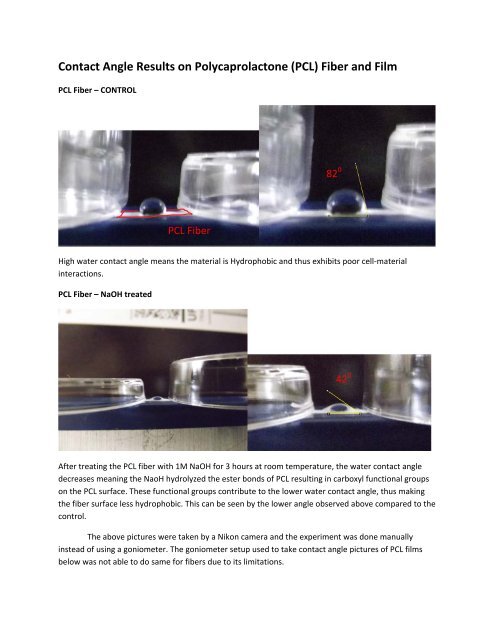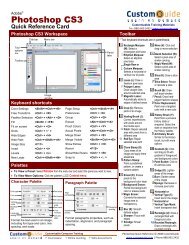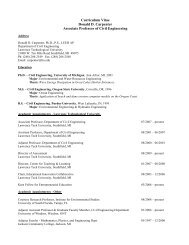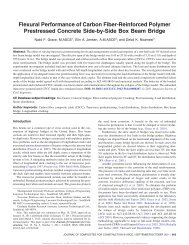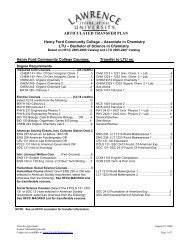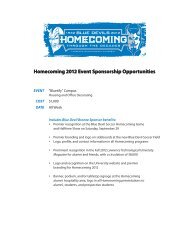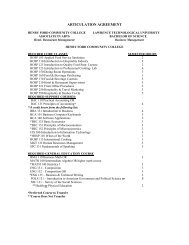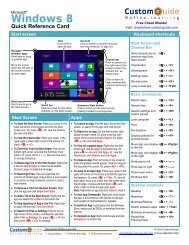Contact Angle Results on Polycaprolactone (PCL) Fiber and Film
Contact Angle Results on Polycaprolactone (PCL) Fiber and Film
Contact Angle Results on Polycaprolactone (PCL) Fiber and Film
Create successful ePaper yourself
Turn your PDF publications into a flip-book with our unique Google optimized e-Paper software.
<str<strong>on</strong>g>C<strong>on</strong>tact</str<strong>on</strong>g> <str<strong>on</strong>g>Angle</str<strong>on</strong>g> <str<strong>on</strong>g>Results</str<strong>on</strong>g> <strong>on</strong> Polycaprolact<strong>on</strong>e (<strong>PCL</strong>) <strong>Fiber</strong> <strong>and</strong> <strong>Film</strong><br />
<strong>PCL</strong> <strong>Fiber</strong> – CONTROL<br />
82 0<br />
<strong>PCL</strong> <strong>Fiber</strong><br />
High water c<strong>on</strong>tact angle means the material is Hydrophobic <strong>and</strong> thus exhibits poor cell‐material<br />
interacti<strong>on</strong>s.<br />
<strong>PCL</strong> <strong>Fiber</strong> – NaOH treated<br />
42 0<br />
After treating the <strong>PCL</strong> fiber with 1M NaOH for 3 hours at room temperature, the water c<strong>on</strong>tact angle<br />
decreases meaning the NaoH hydrolyzed the ester b<strong>on</strong>ds of <strong>PCL</strong> resulting in carboxyl functi<strong>on</strong>al groups<br />
<strong>on</strong> the <strong>PCL</strong> surface. These functi<strong>on</strong>al groups c<strong>on</strong>tribute to the lower water c<strong>on</strong>tact angle, thus making<br />
the fiber surface less hydrophobic. This can be seen by the lower angle observed above compared to the<br />
c<strong>on</strong>trol.<br />
The above pictures were taken by a Nik<strong>on</strong> camera <strong>and</strong> the experiment was d<strong>on</strong>e manually<br />
instead of using a g<strong>on</strong>iometer. The g<strong>on</strong>iometer setup used to take c<strong>on</strong>tact angle pictures of <strong>PCL</strong> films<br />
below was not able to do same for fibers due to its limitati<strong>on</strong>s.
<strong>PCL</strong> films were cast in a st<strong>and</strong>ard 6‐well culture plate, thus overcoming the size limitati<strong>on</strong>s of<br />
g<strong>on</strong>iometer. Each film had a diameter of 35 mm <strong>and</strong> were dried before performing the test.<br />
<strong>PCL</strong> <strong>Film</strong>s – C<strong>on</strong>trol<br />
73 0 64 0<br />
A high water c<strong>on</strong>tact angle can be seen here just as the <strong>Fiber</strong>.<br />
<strong>PCL</strong> <strong>Film</strong> – Plasma treated<br />
Plasma treatment decreases the angle a little but not significantly. It is important to note that the<br />
c<strong>on</strong>tact angle analysis was d<strong>on</strong>e after 4 days of plasma treatment.
<strong>PCL</strong> <strong>Film</strong> – Plasma + NaOH treatment<br />
NaOH treatment following plasma treatment showed result similar to the <strong>Fiber</strong>.<br />
42 0<br />
C<strong>on</strong>clusi<strong>on</strong>:<br />
NaOH treatment is an aqueous based treatment. By principle, aqueous treatments should not work <strong>on</strong><br />
any hydrophobic surface e.g. polycaprolact<strong>on</strong>e (<strong>PCL</strong>). Thus a pretreatment of <strong>PCL</strong> with plasma was<br />
essential. Plasma increases the surface energy of a surface, thus making it less hydrophobic, which is<br />
essential for an aqueous based (NaOH) treatment.<br />
<str<strong>on</strong>g>C<strong>on</strong>tact</str<strong>on</strong>g> angle pictures of <strong>PCL</strong> fiber treated with NaOH were taken October 2012 before we<br />
decided to do plasma pretreatment. Since then, we performed the c<strong>on</strong>tact angle test <strong>on</strong> plasma treated<br />
fiber <strong>and</strong> plasma + NaOH treated fiber. The test showed complete wettability meaning a water c<strong>on</strong>tact<br />
angle of 0 0 . Further tests are needed to be c<strong>on</strong>ducted <strong>on</strong> the fiber using g<strong>on</strong>iometer setup.


